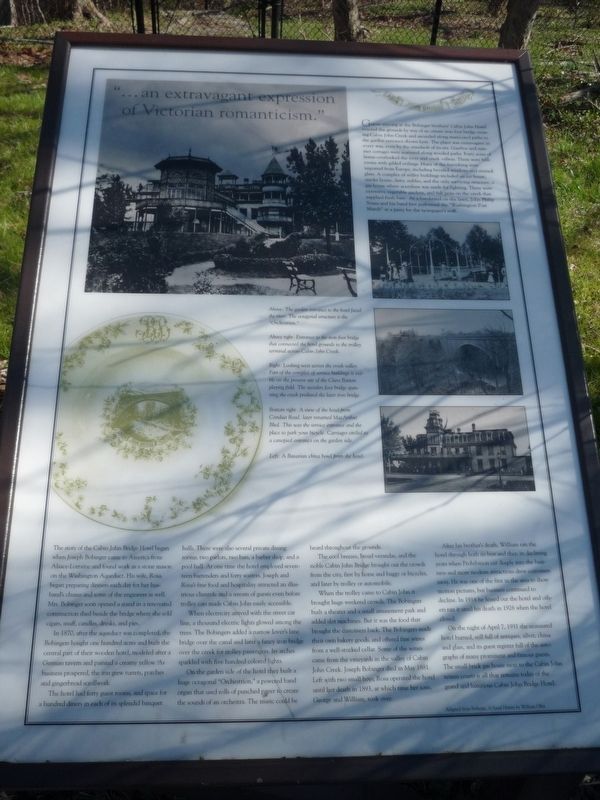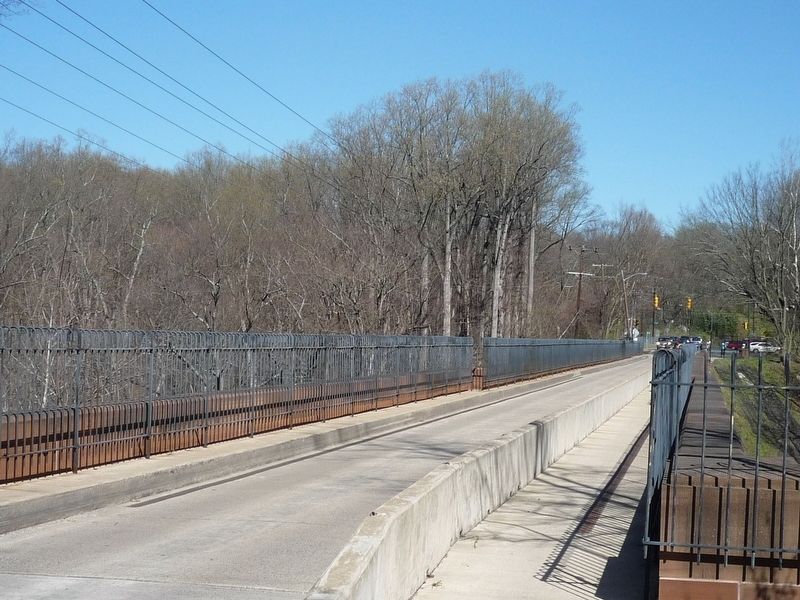"…an extravagant expression of Victorian romanticism."
Guests at the Bobinger brothers’ Cabin John Hotel entered the grounds by way of an ornate iron foot bridge crossing Cabin John Creek and ascended along manicured paths to the garden entrance shown here. The place was extravagant in every way, even by the standards of its era. Gazebos and summer cottages were scattered along wooded paths. Forty acres of lawns overlooked the river and creek valleys. There were ballrooms with gilded ceilings. Many of the furnishings were imported from Europe, including beveled windows and stained glass. A complex of utility buildings included an ice house, smoke house, dairy, stables, and the only surviving structure, a gas house where acetylene was made for lighting. There were extensive vegetable gardens, and fish pens on the creek that supplied fresh bass. At a bandstand on the lawn, John Philip Sousa and his band first performed the “Washington Post March” at a party for the newspaper’s staff.
The story of the Cabin John Bridge Hotel began when Joseph Bobinger came to America from Alsace-Lorraine and found work as a stone mason on the Washington Aqueduct. His wife, Rosa, began preparing dinners each day for her husband’s chums and some of the engineers as well. Mrs. Bobinger soon opened a stand at a renovated construction shed beside the bridge where she sold cigars, snuff, candles,
drinks, and pies.In 1870, after the aqueduct was completed, the Bobingers bought one hundred acres and built the central part of their wooden hotel, modeled after a German tavern and painted a creamy yellow. As business prospered, the inn grew turrets, porches and gingerbread scrollwork.
The hotel had forty guest rooms, and space for a hundred dinners in each of its splendid banquet halls. There were several private dining rooms, two parlors, two bars, a barber shop, and a pool hall. At one time the hotel employed seventeen bartenders and forty waiters. Joseph and Rosa’s fine food and hospitality attracted an illustrious clientele and a stream of guests even before trolley cars made Cabin John easily accessible.
When electricity arrived with the streetcar line, a thousand electric lights glowed among the trees. The Bobingers added a narrow lover’s lane bridge over the canal and later an iron bridge over the creek for trolley passengers. Its arches sparkled with five hundred colored lights.
On the garden side of the hotel they built a huge octagonal “Orchestrion,” a powered band organ the used rolls of punched paper to create the sounds of an orchestra. The music could be heard throughout the grounds.
The cool breezes, broad verandas, and the noble Cabin John Bridge brought out the crowds from the city, first by horse and buggy or bicycles,
When the trolley came to Cabin John it brought huge weekend crowds. The Bobingers built a theater and a small amusement park and added slot machines. But it was the food that brought the customers back. The Bobinger’s made their own bakery goods, and offered fine wines from their well-stocked cellar. Some of the wines came from the vineyards in the valley of the Cabin John Creek. Joseph Bobinger died in May 1881. Left with two small boys, Rosa operated the hotel until her death in 1893, at which time her sons, George and William took over.
After his brother’s death, William ran the hotel through both its best and then its declining years when Prohibition cut deeply into the business and more modern attractions drew customers away. He was one of the first in the area to show motion pictures, but business continued to decline. In 1914 he leased out the hotel, and others ran it until his death in 1926 when the hotel closed.
On the night of April 7, 1931, the uninsured hotel burned, still full of antiques, silver, china and glass and its guest register full of the autographs of many prominent and famous guests. The small brick gas house next to the Cabin John tennis courts is all that remains today of the grand and luxurious Cabin John Bridge Hotel.
(Adapted from Bethesda, a Social History by William Offut.)
Topics.
Location. 38° 58.355′ N, 77° 8.98′ W. Marker is in Cabin John, Maryland, in Montgomery County. Marker is on MacArthur Boulevard, on the right when traveling east. Touch for map. Marker is at or near this postal address: 7400 MacArthur Blvd, Cabin John MD 20818, United States of America. Touch for directions.
Other nearby markers. At least 8 other markers are within walking distance of this marker. Building The Cabin John Bridge (here, next to this marker); "The best scenery lies beyond the city, especially in the neighborhood of Cabin John Creek…" (here, next to this marker); A Life of Service (approx. 0.6 miles away); A Heroine's Home (approx. 0.6 miles away); Clara Barton House (approx. 0.6 miles away); a different marker also named The Clara Barton House (approx. 0.6 miles away); “A riotous country jumble” (approx. 0.6 miles away); The Clara Barton Trail (approx. 0.6 miles away). Touch for a list and map of all markers in Cabin John.
More about this marker. The upper left shows a photo of the hotel, captioned, The garden entrance to the hotel faced the river. The octagonal structure is the “Orchestrion.” On the upper right is a photo showing the Entrance to the foot bridge that connected the hotel grounds to the trolley terminal across Cabin John Bridge. In the right center another photo is a view Looking west across the creek valley. Part of the complex of service buildings is visible on the present site of the Clara Barton playing field. The wooden foot bridge spanning the creek predated the later iron bridge. And in the lower right of the photo set is a A view of the hotel from Conduit Road, later renamed MacArthur Blvd. This was the service entrance and the place to park your bicycle. Carriages circled to a canopied entrance on the garden side. On the lower left is a photo of A Bavarian china bowl from the hotel.
Credits. This page was last revised on January 10, 2021. It was originally submitted on January 8, 2021, by Richard E. Miller of Oxon Hill, Maryland. This page has been viewed 229 times since then and 20 times this year. Photos: 1, 2, 3. submitted on April 11, 2009, by Richard E. Miller of Oxon Hill, Maryland. • Devry Becker Jones was the editor who published this page.


